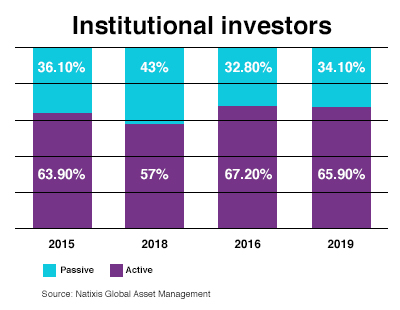Has the relative stability of market returns in recent years lulled clients into a false sense of security about passive investing? According to institutional investors and wholesale portfolio managers (i.e., those who manage portfolios for certain insurance investment platforms, fund-of-fund solutions and third-party asset management platforms), this could be a significant issue facing individuals when markets turn more volatile. Now may be a good time to discuss with clients how an active strategy can make a difference in turbulent markets.
When times get tough, invest like a pro
Professional investors anticipate increased financial market volatility in 2017. Citing the impact of geopolitical uncertainty and low yields as the primary catalysts, a recent survey1 revealed that approximately 50% of institutional investors and 68% of wholesale portfolio managers are likely to trim their return expectations in the next 12 months.
Advisors may want to take this opportunity to help clients understand how professional investors are positioning their portfolios for a potential market change, and how clients can benefit from a similar approach. In particular, both institutions and wholesale managers are not shying away from the risks presented by an increasingly frothy market. Instead, they are making a calculated determination that increased allocations to actively managed investments may help generate returns and manage risk.
“Most investors have unrealistic return expectations for the level of risk they can tolerate. Add in market volatility and that can lead to what advisors believe is the top mistake by many investors: emotional decisions,” said David Goodsell, Executive Director of Natixis Global Asset Management’s Durable Portfolio Construction Research Center, located in Boston, MA. “When uncertainty rises, you need a strategy to manage risk. Active managers can evaluate individual securities and select the most attractive opportunities. Investors need to understand the value of this approach.”
Limitations of passive investing
Passive investments are not risk-free, which is something investors don’t always know. Over the past decade, global monetary policy has profoundly affected market performance. Where markets driven by corporate earnings tend to reward stocks of top-performing companies, policy-driven markets have created a rising tide in which all stocks – good performers and underperformers – are lifted equally. Many professional investors worry that recent experience has lulled investors into a false sense of security about passive investing, while most institutional decision-makers believe investors are uninformed about the risks of indexing.
Investors may see a cost advantage from passive investments, but many also assume greater benefits: 58% of Canadian investors believe passive investing is less risky and 64% believe passive strategies will protect them in a market downturn.2 However, the facts reveal otherwise. By definition, index funds have no built-in risk management component. Investors may get market returns when markets rise, but should realize they are equally exposed to market losses when markets decline.
“That’s why education now, before volatility spikes, is key to addressing this type of investing disconnect,” said Goodsell. “It’s an opportunity to remind clients of why they own specific investments, how they are likely to react to volatility and what the long-term strategy is for holding the investments within their portfolios.”
Refocused on active investing
Active managers, particularly those who espouse the institutional investing approach of putting risk considerations first when constructing a portfolio, seek ways to minimize risk and protect a portfolio from volatility. As a result, three-quarters of institutional investors1 believe market conditions will be more favourable to active management in 2017. They give the nod to active management for generating both alpha (89%) and attractive risk-adjusted returns (66%).
In anticipation of greater volatility, institutions are also cutting back their projected use of passive investing. In 2015, passive investments accounted for just over one-third of institutional assets (see first bar in chart below). At that time, institutional investors had projected passive could reach as much as 43% of assets by 2018 (second bar). Fast-forward to 2016, and these investors have already trimmed their passive holdings to 32.8% (third bar), while anticipating their passive allocations will increase only 1.3 percentage points from that reduced level by 2019 (fourth bar).

Institutional allocations show that the real story is not to pit active against passive. Instead, each approach should be used strategically within portfolios. While active is generally better suited to generating alpha, passive offers a fee advantage. Advisors will serve clients well if they look at each individual’s financial and life circumstances, in addition to prevailing market conditions and trends, to determine the appropriate mix of active and passive investments in their clients’ portfolios.
Visit durableportfolios.com to learn more about the Natixis active approach to portfolio construction.
1 Natixis Global Asset Management, 2016 Global Survey of Institutional Investors.
2 Natixis Global Asset Management, 2016 Global Survey of Canadian Investors.
Partner Reports is a space made available for businesses who wish to publish content for financial professionals. Investment Executive journalists are not involved in writing these articles.